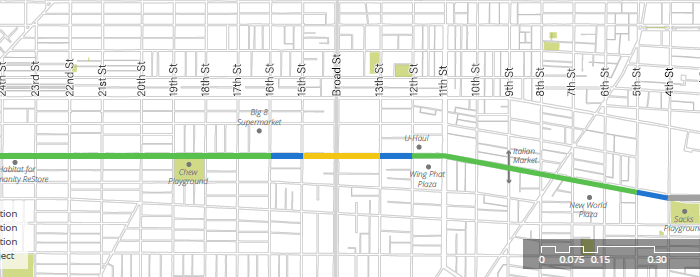PHILADELPHIA – Following extensive public outreach conducted earlier this year, the City announced today that it will reconfigure Washington Avenue from its current five-lane layout to a three-lane layout between 4th Street to Grays Ferry Avenue as part of a repaving project scheduled for 2021.
The City’s Office of Transportation, Infrastructure and Sustainability (OTIS) asked residents, businesses and community organizations for input on three design options for Washington Avenue. The team used a combination of print and digital methods, including an online survey, paper mailer, online meetings, phone calls, and materials in English, Spanish, Simplified Chinese, and Vietnamese.
“OTIS received over 5,400 responses to the outreach efforts – an overwhelming response” said Deputy Managing Director Mike Carroll. “Seventy-one percent of online survey respondents preferred the three-lane design over the other two alternatives presented.” View engagement results here.
This option changes Washington Avenue’s current layout of five driving lanes, two parking lanes, and two bike lanes to a layout of three driving lanes, two parking lanes, and two parking-protected bike lanes.
Over the years, the City has heard many concerns about the current conditions of the roadway from neighbors and businesses. OTIS performed traffic analysis to see what layout options would work and what would not work.
OTIS also found that there were 254 crashes on Washington Avenue between 2012 and 2018. Pedestrians and cyclists are over-represented in these crashes. The new layout will provide safety improvements for anyone using the street, especially those walking and biking.

The three-lane layout will extend from Grays Ferry Avenue to 16th Street and from 12th Street to 5th Street, as seen in green in the image above. The stretch from 15th Street to 13th Street, seen in yellow, will remain as it is today, due to high vehicle volumes around Broad Street. A transitional four-lane cross-section, shown in blue, will connect the 3 and 5-lane sections and will also transition drivers to the Delaware River Waterfront Corporation (DRWC) project area between 4th Street and Delaware Avenue.
Benefits of the new layout include:
- Separating people riding bicycles from people driving cars
- Improving safety for people walking as they will only have to cross three driving lanes instead of today’s five
- Increasing pedestrian space on Washington Avenue West of Broad Street where the sidewalks are very narrow
- “Floating Bus Islands” for SEPTA Route 64 riders on every bus stop so riders can safely get on and off the bus
- The traffic signals along Washington Avenue will be re-timed to improve vehicle flow
- New loading spaces to alleviate double-parking and needs identified by businesses in separate surveys. New timed parking regulations will help create more frequently available short-term parking.
The tradeoffs for these safety improvements include slightly longer travel times for people driving at rush hour (about 15 seconds per block), and an anticipated five to ten percent increase in vehicles that will use surrounding streets instead of Washington Avenue at rush hour.
Next steps for the project include developing final engineering plans and preparing the project to bid. Construction is anticipated for summer 2021. OTIS will continue regular communications with City Council, neighbors, businesses, and organizations before, during, and after paving in 2021.
A video explaining the layout decision, the three-lane option in detail, and next steps for the Washington Avenue’s Repaving & Improvement Project is available here.
Note: The Delaware River Waterfront Corporation (DRWC) is working on a large project between Columbus Boulevard and 4th Street. The City will re-pave those blocks as part of the Washington Avenue project, but the roadway layout in that section was determined as part of DRWC’s approved project.
About the Office of Complete Streets
The Office of Transportation, Infrastructure and Sustainability (oTIS) coordinates the implementation of Complete Streets policies in Philadelphia. Complete Streets are designed to ensure safe access for all users, including pedestrians, bicyclists, motorists, and transit riders. The City’s Complete Streets policy was introduced in 2009 and requires a review of every construction project’s impact on roads, sidewalks, and the bicycle and transit network to ensure that all affected streets adhere to the City policy. This policy improves safety, promotes economic development, reduces congestion, and encourages active transportation. Under the Complete Streets program, oTIS manages the City’s parklet, bike corral, and pedestrian plaza programs.
